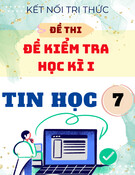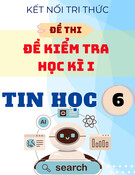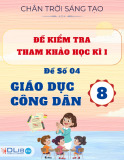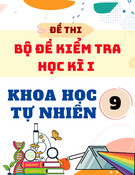
_______________________________________________
PART I: QUESTION 1 - LISTENING COMPREHENSION: (1 – 20) (2.0 pts)
(Thí sinh nghe 02 đoạn ghi âm mỗi đoạn 02 lần. Bắt đầu và kết thúc phần nghe đều có
nhạc. CD đã được ghi đủ số lần, giám thị mở cho máy chạy từ đầu tới cuối không cần trả
CD. Tổng thời lượng của CD là: khoảng 25 phút. Giữa các đoạn có khoảng im lặng để thí
sinh làm bài)
SECTION 1: You will hear a conversation between a student looking for her
family and a housing adviser.
Complete the notes below (1-10). Write NO MORE THAN THREE WORDS AND/OR
A NUMBER for each answer.
HOST FAMILY APPLICANT
Example Answer
Name: Jenny Chan
Present address: Sea View Guest House, (1) _______
Daytime phone number: 2237676
(NB Best time to contact is (2) _______)
Age: 19
Intended length to stay: (3) _______
Occupation while in the UK: student
General level of English: (4) _______
Preferred location: in the (5) _______
Particular requirement for diet: (6) _______
Other requirements: own facilities
own television
(7) _______
to be (8) _______
Maximum price: (9) £______ a week
Preferred starting date: (10) ______
Môn Tiếng Anh Ngày thi: 27/3/2024 Trang 1/9
SỞ GIÁO DỤC VÀ ĐÀO TẠO
TỈNH TIỀN GIANG
(Đề thi có 09 trang)
KỲ THI CHỌN HỌC SINH GIỎI CẤP TỈNH
TRUNG HỌC CƠ SỞ
Năm học 2023-2024
Môn thi: TIẾNG ANH
Thời gian làm bài: 150 phút, không kể thời gian phát đề
Ngày thi: 27/3/2024
ĐỀ THI CHÍNH THỨC

SECTION 2: (11-20)
You will hear a talk about scientific research in the continent of Antarctica.
Complete the notes below
WRITE NO MORE THAN THREE WORDS AND/OR A NUMBER for each answer.
ANTARCTICA
GEORGRAPHY
world’s highest, coldest and windiest continent
more than (11) _______ times as big as the UK
Most of the area is classified as (12) _______
RESEARCH STATIONS
international teams work together
(13) _______ is integrated with technical support
stations contain accommodation, work areas, a kitchen, a (14) _______ and a gym.
supplies were brought to Zero One station by sledge from a (15) _______ at the edge of
the ice 15 km away
problem of snow build-ups solved by building stations on (16) _______ with adjustable
legs
FOOD AND DIET
average daily requirement for an adult in Antarctica is approximately (17) _______
kilocalories
rations for field work prepared by a process of freeze-drying
RESEARCH
the most important research focuses on climate change, including
-measuring changes in the icecaps (because of effects on sea levels and (18) _____
- monitoring the hole in the ozone layer
-analyzing air from bubbles in ice to measure the (19) _______ caused by human
activity.
WORK OPPORTUNITIES
Many openings for (20) _______ people including
- research assistants
- administrative and technical positions
PART II: READING COMPREHENSION: (6.0 pts)
QUESTION 2. READING 1 : Read the passage below, then choose ONE option that
best answers or completes each of the questions (21-33):
Môn Tiếng Anh Ngày thi: 27/3/2024 Trang 2/9

If You Can Get Used to the Taste
There is a formal word for it: entomophagy. It means the consumption of insects by us,
human beings. Okay, we are not insectivores (eaters of insects), although, it must be
admitted, our primate cousins regularly feast on insects. Sure, but those relatives live in
trees, and swing from branches, and we don’t. Okay, you say, snails, those slimy garden
pests, are relished as a gourmet food, most famously by the French, who are otherwise not
interested in garden life. But, I counter, snails are not insects. They are mollusks, and I’d
like to think that makes a difference.
What I’m talking about is eating true insects, those with six legs, three body parts, hard
exoskeleton, and two antennae. We can extend this definition to our eight-legged arachnids
(spiders and scorpions), as well. These are creatures people just don’t eat. At least, that was
what I thought, until I met a personally as well as ecologically-friendly young man, Peter
Ferguson, who advocates insects as the ultimate in culinary delight. Why? Peter explains,
‘For a start, there are many insects, about 10 million species, and a huge biomass of high
quality calories, and we just ignore them. In a world having trouble feeding itself, that
doesn’t make sense.’
Ignore them we do, at least in Western culture, where we have long had much better
alternatives. Animal husbandry has characterised our societies, giving us pork, poultry, and
cattle, upon which we regularly feast. Yet other cultures don’t have it so lucky, in Africa, in
Asia, and among aboriginal or ethnic groups in Oceania, insects have an equally long
history as an important dietary supplement, from butterflies and moths, to bees and wasps,
cockroaches and ants, beetle grubs or larvae, caterpillars and worms, scorpions (a delicacy
in southern China) and tarantulas. Even the Christian Bible states that John the Baptist lived
on locusts and wild honey, locusts being grasshoppers in their swarming stage. These same
insects, incidentally, are commonly eaten in Thailand, where a visit to a market there will
reveal multitudes, deep-fried in glistening piles for the delectation of passing shoppers.
Consider the African mopane worm, for example. To begin with, the name is a misnomer.
The creature is actually a large colourful caterpillar, which, in the fullness of time, turns into
a rather dull-looking moth, although most never reach that stage. The hairy yellow- striped
creatures are eagerly sought after, hand-picked from trees in the wild, pinched by the tail
end to squeeze out the slimy green intestinal tract, after which they are most often sun-dried
or smoked, thereafter ready for consumption. Tins of mopane worms in brine, or in tomato
or chili sauce are common in supermarkets. They can be eaten straight from the can. fried
into crunchy snacks, or added as an ingredient to conventional dishes. The harvest and sale
of wild mopane worms is now a multi-million dollar industry, feeding millions of people,
mostly indigenous Africans.
Môn Tiếng Anh Ngày thi: 27/3/2024 Trang 3/9

Peter is enthusiastically telling me why he does it. ‘Insects have protein, and all the
vitamins, minerals, and fat you could want.’ When I remain skeptical, Peter holds up a fried
grasshopper. ‘This has lots of calcium’. Then comes the (you guessed it) termite paste, a
black smear with the look, smell, and consistency, of an industrial solvent. ‘Iron. Very rich.’
Then comes the grublike larvae of some form of moth. ‘Essential trace elements such as
zinc and copper.’ Anything else?
‘Insects don’t produce greenhouse gases, and don’t need antibiotics.’ Peter even cites my
mopane worm example. ‘Three kilograms of mopane leaves will feed a kilogram of worms
— a 30% payback. With cattle, it’s less than 10%. Insects are cheap to buy, cheap to breed,
and easy to manage.’
One can’t argue with that. The phenomenal rate at which insects breed is well known, and
more than makes up for their small size. A female cricket might be a fraction of the weight
of a huge beef cow, but lays up to 1,500 eggs a month, converted into food at 20 times the
rate of beef, whilst using only a fraction of the space and water. The ecological argument for
entomophagy is undeniable, although there are significant concerns about internal parasites,
and the accumulation of pesticides and toxins inside many wild insects. Allergic reactions
have also been reported. Cooking insects well is recommended, and their consumption
should, of course, be avoided, after intensive pesticide use or commercial spraying of local
agricultural lands.
But what about the taste? Here, Peter hesitates. He finally comes out with a suspicious,
‘You get used to it.’ When I nod skeptically, he comes out with a far more confident,
‘Actually, you’re eating insects already, all the time.’ Yes, apparently, insects find their way
into the human food chain, whether we like it or not. For example, most of those who eat
rice (as I do) are inadvertently eating not just a few rice weevil larvae, and probably
benefited by this, given the additional vitamins these larvae supply. Whole insects, insect
parts, insect detritus, larvae, and excrement, appear in all our food, but in such small
quantities that they are basically unnoticed and insignificant. Peter smiles. ‘In that sense,
we’re already insectivores. We’ve just got to take the next logical step.’
Do the following statements agree with the information given in the Reading Passage?
Write
TRUE if the statement agrees with the information.
FALSE If the statement contradicts the information.
NOT GIVEN If there is no information on this.
21. The French are well known for eating insects.
22. Peter Ferguson is a nature-friendly person.
23. Insect eating by people is a modern phenomenon.
24. Some insects are used for religious purposes.
Complete the table
CHOOSE NO MORE THAN TWO WORDS from the passage for each answer.
Môn Tiếng Anh Ngày thi: 27/3/2024 Trang 4/9

Insect One fact Another fact
grasshoppers contain (25)_______ popular in (26) _______
mopane worms primarily eaten by
(27_______
eat (28) _______
scorpions are popular in (29) _______ are a type of (30) _______
31. Mopane worms
A. are appropriately named. B. usually reach their moth form.
C. are extensively raised for profit. D. are usually treated before being eaten.
32. Insects
A. multiply quickly. B. are best eaten raw.
C. are mostly safe to eat. D. produce small amounts of greenhouse gas.
33. The author
A. likes snails. B. probably eats mopane worms.
C. believes insects can taste good. D. probably eats rice weevil larvae.
QUESTION 3. READING 2 : (34-37) The Reading passage has 4 paragraphs (A-
D). Choose the correct heading for each paragraph from the list of headings below.
There are 3 extra ones that we do not need to use.
List of headings
i. A possible explanation
ii. Why names of objects are unhelpful
iii. Checking out the theory
iv. A serious state of affairs
v. The need to look at how words are formed
vi. How age impacts on learning colors
vii. Some unsurprising data
LEARNING COLOR WORDS
Young children struggle with color concepts, and the reason for this may have
something to do with how we use the words that describe them.
A. In the course of the first few years of their lives, children who are brought up in English-
speaking homes successfully master the use of hundreds of words. Words for objects,
actions, emotions, and many other aspects of the physical world quickly become part of
their infant repertoire. For some reason, however, when it comes to learning color words,
the same children perform very badly. At the age of four months, babies can distinguish
between basic color categories. Yet it turns out they do this in much the same way as blind
children. “Blue” and “yellow” appear in older children‘s expressive language in answer to
questions such as “What color is this”, but their mapping of objects to individual colors is
haphazard and interchangeable. If shown a blue cup and asked about its color, typical two-
year-olds seem as likely to come up with “red” as “blue”. Even after hundreds of training
Môn Tiếng Anh Ngày thi: 27/3/2024 Trang 5/9


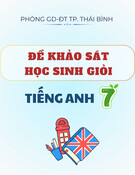
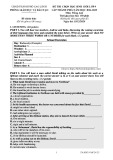




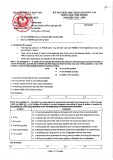


![Đề tham khảo ôn tập học kì 1 môn Toán lớp 6 năm 2025-2026 - Trường Trung học Thực hành Sài Gòn [Mới nhất]](https://cdn.tailieu.vn/images/document/thumbnail/2025/20251206/tnkhanh@sgu.edu.vn/135x160/64331765161604.jpg)


